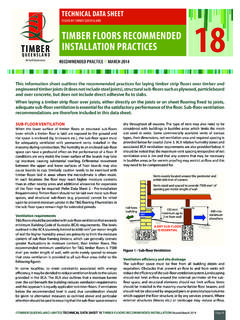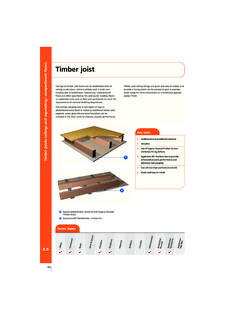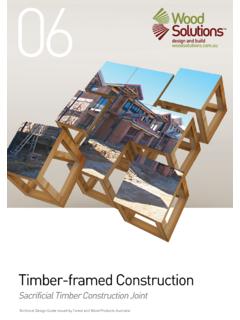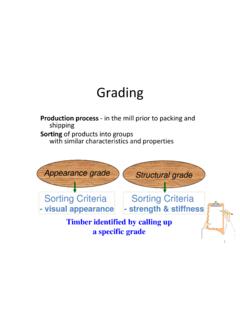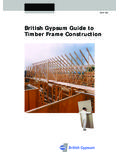Transcription of Upgrading the fire resistance of floors and doors in ...
1 International Symposium on Protection of Cultural Heritage Buildings from Fire, Kyoto, April 6-7, 2003 Upgrading the fire resistance of floors and doors in heritage buildingsGordon Cooke BSc PhD CEng MICEMIMechE FIFireEInternational Fire Safety Consultant and Visiting Professor, School of Engineering, City University, London, UKHeritage fire protection some considerations A property fire risk assessment should be made before any Upgrading of structural fire precautions. Consider importance and value of items at risk structure, furnishings, contents. Consider importance of site as a revenue earner Have all plausible fire /smoke routes been identified? Can fire detection be improved can aspirated smoke detection be justified? Can in-house staff get to incipient fires in time to extinguish them what about fires in cavities and fires at high level?
2 What fire suppression devices are available for immediate use Can fire safety management be improved can 24 hour surveillance be afforded? What is attendance time of fire service appliances? Has fire plan been considered in sufficient detail. Staff may not be able to remove important items to a place of safety and fight incipient fire at the same time What benefits will structural fire precautions bring? Improving fire compartmentation by Upgrading the fire resistance of doors and floors (the subject of this presentation) is an important, but small part, of the overall fire safety strategy All attempts should be made to leave the fabric and structure of the building in its original form Structural improvements should be invisible if possible. This is sometimes possible, and examples will be shown to demonstrate how to do this for floors and doorsHSE fire risk assessment planSource: Home Office et al, Fire Safety.
3 An employer s guide, HSE Books, London, UK, 1999 This plan is concerned with life safety. Similar approach needed for determining precautions against loss of property (loss of building structure and fabric and building contents furniture and paintings) and loss of business continuity and, of course, loss of cultural heritage. Employer starts to assess fire safety inworkplaceEmployer appoints person to carry out assessmentPlan and prepare for carrying out assessmentIdentify fire hazards- sources of ignition- sources of fuel- work processesIdentify location of people at significant riskin case of fireEvaluate the risksAre existing fire safety measures adequate?-control of ignition sources/sources of fuel- fire detection/warning- means of escape- means of fighting fire- maintenance and testing of fire precautions-fire safety training of employeesCarry out any improvements neededRecord findings and action takenPrepare emergency planInform.
4 Instruct and train employees in fireprecautionsKeep assessment under reviewRevise if situation changesStep 1 Step 2 Step 3 Step 4 Step 5 Stopping fire spread through floor and ceiling cavitiesFire spread routes above ceiling at door position resistance to all fire spread routes should be considered Fire resistance of over door panel should not be forgotten Cavity barrier above ceiling is necessary and should line up with door position Light fittings and other fittings in ceiling may be points of weaknessCavity barriernecessary hereFire doorFloorOverdoor panel shouldbe fire resistingCeilingDoor framePossible fire pathsto be preventedLight fittingUnderside of floorFlexible ceiling cavity fire barrier using rock wool Cavity barrier needed to prevent horizontal fire spread. Barrier should be flexible to accommodate relative movements of structure Flexible rock wool skirt can be used to follow movement Underside of floor or roofCeilingCeiling in fireDirection of flow of smoke and hot gasesSystem willacceptmovementRock wool skirt (possibly weighted down to prevent uplift due to pressure variations,as at flashover )
5 Cavity barrierboard materialCeiling cavity barrier using spray material Expanded metal mesh is placed in a curved shape in the cavity and fixed to floor and ceiling Lightweight fire protecting spray is applied at sufficiently low density to provide some flexibility Has the advantage that it fills all the is that it is a wet trade and can be messy, and may involve of floor or roofCeilingCeiling in fireDirection of flow of smoke and hot gasesSystem willacceptmovementRock wool skirt (possibly weighted down to prevent uplift due to pressure variations,as at flashover ) Cavity barrierboard materialIncreasing the fire resistance of floorsFire resistance test criteria3mFurnace enclosureInstabilityor collapseLoss ofintegrityExcessivetemperatureriseFloor which needs no Upgrading Fan vaulted brickwork is ideal shape to carry load.
6 Brickwork in compression behaves well in fire provided perimeter restraint exists Cast iron columns are fire protected with intumescent spray. Basic form still seen, retaining of historic ceiling Clearly unacceptable to apply structural fire protection to underside of this ceiling May be possible to increase the fire resistance from above the floor Any fire precautions should consider smoke damage as well as a fully developed fire. Cavity barriers within floors may be needed. Best option is early fire detection (by aspiration) and rapid fire suppression by trained staff. In small rooms automatic water spray might be appropriate as fire suppression Impossible to upgrade the fire resistance of this ceiling from below without destroying aesthetic Cost of closing the building (which houses an important collection of paintings and furniture) unacceptable.
7 Is Upgrading necessary? Could floor be upgraded from above? Upgrading by adding new ceiling below Existing floor boards and ceiling are in poor condition. Access to top and bottom available. Aesthetics not important New ceiling can be added using fire protecting ceiling boards and timber battens Old ceiling kept in place for thermal protection using chicken wire mesh Fixings important BRE Digest 208 guidesPlain edge timber boardingExisting ceiling in poor conditionTimber joistAdditional boardedceilingAdditional timberprotectionChicken wireTimber battensExisting ceilingCharring rate of timber versus radiation intensity Charring rate depends markedly on radiation intensity For ISO 834 fire exposure, timber charring rate is in the approximate range to mm/min according to DD ENV -1-2 and BS PD 7974-3, 2003 Source: Butcher E G, Do we know how fast it burns?
8 Fire Surveyor,Dec 1976 and FRS FR Note 896, Note on charring rates in wood, Nov 1971 100050010050101110550100500 Radiation intensity, W/cmUK charring ratesUSA charring rate data (nuclear test simulation) mm/minRadiation in real fires4 Charring rate, cm/s x 10 timber floor using inset ceiling Existing floor of poor integrity. Large beams. Inset ceiling considered aesthetically acceptable Inset ceiling can be fire protecting board or plaster (or expanded metal mesh if adequately supported mid-span Residual section of floor beam calculated to be structurally acceptable. Residual section assumed to have room temperature strength. Neutral axis of section has moved. Ceiling fastener ( woodscrew) needs to allow for charring of batten around fastener Additional timber protection (sheeting) gives integrity against cold and hot smoke Radius of char = char thicknessRTT = RAdditional timberprotectionLarge sectiontimber floor beamExisting floor boardsof poor integrityNew ceiling boardChar lineTimber battens addedUpgrading a timber floor by adding plaster or mineral fibre from the top floor boards are in poor condition with square edges.)
9 Historic moulded ceiling also in poor condition typically plaster on timber lath loosely held with corroded nails. Access only from the upper face. Upgrading process: temporarily remove some floor boards, place damp proof sheet, fix expanded metal to sides of joists, pour in lightweight plaster, replace floor boards, apply timber sheeting to improve integrity and resistance to smoke flow if necessary. Added ceiling of plaster and metal lath must remain in place after historic ceiling falls away. Damp proof sheet must be pushed tightly into corners so that new plaster protects faces of joists Can floor carry additional weight? Can ceiling carry wet mass of plaster ? (OK when dry and rigid)Access to cavity by raising floor boardsDamp proof sheetingExisting ceilingof poor integrityMineral fibreinfillExisting ceilingof good integritySteel wire meshnailed to timber joistPlaster infillUpgraded floor using poured plaster Example of mKenwood library ceiling by Robert Adam Early fire detection and suppression essential Major risk is of fire starting above ceiling in roof space.
10 Aspiration could deal with detection in roof space and at high level under ceiling. How deal with fire above ceiling? Fire fighting a problem?Increasing the fire resistance of timber doorsHistoric door and ceiling. Fire risk assessment essential. Objective should be early fire detection and immediate fire suppression this is question for fire safety management. Why is structural fire protection necessary? Necessary structural fire protection must be unseen. Can intumescent be used for improving fire integrity at door edges and at thin areas of door face? Can door be dismantled to allow hidden improvements to be made?Bowing of timber door in fire Bowing will be constrained by hinges and latch Timber door will bow towards the fire due to shrinkage of fire-exposed face. Extent of bow depends on design, thickness and grain direction Failure of integrity will occur at top of door first because a) top of door is in hottest environment, and b) outward flow of hot gases causes charring of door frameHingeHingeLatchBowing at swinging edgeBowing athinged edgeBowing at topof timber doorFire behaviour of glazed door Radiation through glass should be considered (ignition of nearby surfaces on unexposed side) Top of door is in most severe environment Intumescent seal at door edges will prevent emission of hot gases but not cold smoke flow Cold smoke can extensively damage contents of heritage building.

